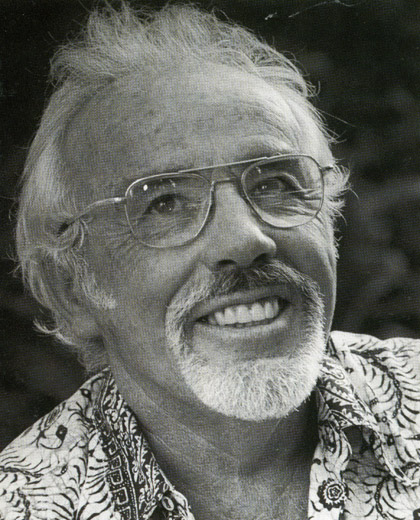Claude Horan, an artist who is considered "the father of ceramics" in Hawaii as well as a renowned waterman, died June 11 at his home in KahaÂluu. He was 96.
Horan, who established the ceramics and glass programs at the University of Hawaii at Manoa art department, left a legacy of artistic creation and education as well as a reputation as a larger-than-life personality with a fun-loving, nonconformist attitude.
"He was all about learning to do new things and take risk," said David Behlke, director of Kapiolani Community College's Koa Gallery, which honored Horan with a Koa Award in 2004. "He always had sort of an irascible sense of humor. The night we did his formal award dinner and presented him with a koa bowl … he wore a T-shirt imprinted with a tuxedo."
James Jensen, curator of modern art at the HonoÂlulu Museum of Art, called Horan "one of the last of the characters, because he had such an eccentric and ‘out there' personality."
"He was just very high-spirited," Jensen said. "You don't encounter that sort of personality too much anymore."
Similarly, Horan's creations often had a whimsical touch. "A masterful thrower" early in his career, according to Jensen, Horan eventually became known for his fancifully abstract female figurines, which began as cylindrically shaped vessels on the potter's wheel and onto which Horan sculpted human features — faces, hands, bloated bellies or breasts.
"His protean spontaneity finds best expression in anthropomorphically manipulated wheel-thrown pots, in which he creates everything from earth goddess fertility figures and Wagnerian-proportioned divas to traditional Hawaiian and JapaÂnese haniwa-inspired clay warriors," said a HonoÂlulu Advertiser review, written on the occasion of Horan's Koa Award.
Horan's work can be found throughout the islands, including sculptures at many public schools, as well as at galleries, private collections and museums throughout the world, including The Smithsonian Institution, which purchased one of his sculptures in 1962. His work is also featured in the book "Claude Horan," published as a guide to a 2004 retrospective on his career at the Koa Gallery and The Contemporary Museum.
Horan was a native of CaliÂforÂnia who grew up surfing and swimming at Southern CaliÂforÂnia beaches. According to the book, he was so strong in the water that he was nicknamed "Duke HoranoÂmoku" and earned an athletic scholarship to college, eventually playing water polo at San Jose State — a relatively quick drive away from the CaliÂforÂnia surf haven Santa Cruz.
Not wanting to study a subject involving books, he took art classes, finding his medium in clay. Studying art also allowed him to go on frequent surfing trips. He is honored in the Santa Cruz Surfing Museum and was credited with naming the popular surf spot Steamer Lane.
Horan eventually received an advanced degree in art and had started a ceramics business in CaliÂforÂnia when he was invited to Hawaii to begin a ceramics program at UH. Years later he also established the glass department, which Jensen said is now one of the top programs within the art department.
Over his 30-year tenure at UH, Horan would have many students who would themselves become renowned artists, among them Toshiko TakaÂezu, Steve Correia and Harue McVay.
"Claude was valuable in that he would encourage you to figure out your way to do it, and then he would be there," Behlke said. "That approach he maintained throughout his teaching career, but it made people dig a little deeper and find some original statement."
With an eye toward supporting ceramists after they graduated, Horan also founded Ceramics Hawaii, a KakaÂako business that served as a supply store and workshop for ceramists. It eventually was taken over by another former student, Isami EneÂmoto.
Bob Flint, an artist on Maui, studied with Horan in the 1960s and 1970s and, like many former students, became friends with his mentor and would go sailing with Horan on his boat on KaneÂohe Bay. Horan was known for sailing the boat in some treacherous conditions.
"His message was to be as creative as possible and have a good time doing it, and just to go for it," Flint said. "His zest for life was evident in his work with those wheel-thrown sculptures that he became so well known for.
"He was full of life and he did everything 100 percent."
Horan is survived by his wife, Suzi.
[caption id="attachment_56919" align="alignleft" width="420"] Claude Horan: He encouraged people to be creative, says a former student. (Courtesy Francis Harr)[/caption]
Claude Horan: He encouraged people to be creative, says a former student. (Courtesy Francis Harr)[/caption]

